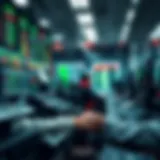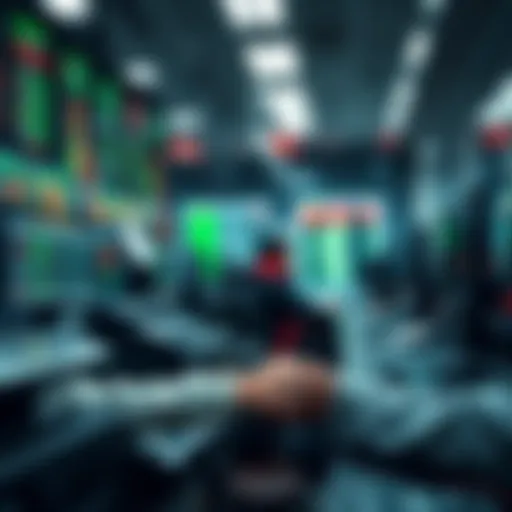Understanding NFT Art: A Deep Dive into Digital Ownership
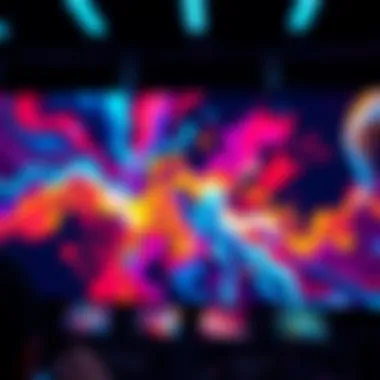

Intro
In recent years, the art world has seen seismic shifts, with non-fungible tokens (NFTs) taking center stage. This digital phenomenon is not just a passing fad; it has changed the way artists create, distribute, and monetize their works. As one engages with the subject of NFT art, it’s crucial to grasp the fundamental concepts at play, alongside their broader implications on both digital and traditional art forms.
Understanding NFT art, however, isn’t just about knowing what NFTs are. It’s about uncovering how they redefine ownership, authenticity, and the artist-audience relationship in a rapidly evolving landscape. The following sections aim to illuminate these intricacies and complexities, arming investors, analysts, developers, and enthusiasts with a detailed comprehension of the NFT art phenomenon.
Prelims to Non-Fungible Tokens
The rise of non-fungible tokens has not merely shifted but rather transformed the facets of digital ownership and artistic expression. In particular, the significance of non-fungible tokens (NFTs) in contemporary art cannot be overstated. As a new breed of digital assets, NFTs introduce concepts that often seem at odds with traditional art markets, redefining how art is created, valued, and owned.
The primary benefit of NFTs lies in their uniqueness. Unlike cryptocurrencies such as Bitcoin or Ethereum, which are interchangeable and possess uniform value, NFTs represent one-of-a-kind items on a blockchain. This distinct characteristic establishes the grounds for discussions surrounding ownership, authenticity, and provenance in the digital space.
NFTs have not only democratized the art world by enabling independent creators to showcase their work without the constraint of conventional galleries, but they also challenge the established norms of how artworks are assessed in terms of market value. The notion of scarcity, once limited to physical artworks, extends into the virtual realm through NFTs, creating an enticing landscape for investors and collectors alike.
Furthermore, with the growing popularity of NFTs, there's a surge of interest from various sectors, including technology, finance, and art advocacy. Understanding NFTs is, therefore, crucial for anyone engaged in the digital economy or looking to navigate the complexities of emerging digital interactions.
"In a world where digital and reality are increasingly blended, NFTs represent a frontier forged on new rules of engagement and ownership."
Engaging with the world of NFTs necessitates an awareness of the broader implications that they hold. From enabling artists to tap into new revenue streams to posing challenges for traditional art markets, they offer lessons in both opportunity and disruption. As we delve further into the exploration of NFTs, it becomes evident that their relevance extends beyond mere technological advancement, inviting a reevaluation of artistic and economic norms that have stood the test of time.
Defining Non-Fungible Tokens
To grasp the essence of NFTs, it’s essential to pinpoint what non-fungible tokens actually represent. At their core, NFTs are digital identifiers that signify ownership of a unique item or piece of content on a blockchain. This variety of token stands in contrast to fungible tokens, such as fiat currency or cryptocurrencies, where each unit is identical and can be exchanged interchangeably. As a result, one may think of NFT-like items as traditional collectibles, comparable to rare stamps or limited-edition coins, which cannot be substituted for one another.
The prevalence of blockchain technology in issuing NFTs ensures that each token carries verifiable data, including its history, ownership, and authenticity. This transparency serves as a safeguard against forgery and theft, empowering artists and collectors with a reliable way to authenticate the originality of the digital pieces they engage with.
The Rise of Digital Assets
In a digitized world, the evolution of art and collectibles increasingly aligns with technology. The past decade has witnessed rapid growth in the acceptance and understanding of digital assets, with NFTs at the forefront of this explosion. Factors such as the shift to online gatherings, the impact of the COVID-19 pandemic, and the expanding reach of social media platforms have all contributed significantly. Artists and enthusiasts are now exploring spaces that were once considered niche.
Notably, platforms like OpenSea, Rarible, and Foundation have emerged, creating ecosystems where creators can mint, sell, or auction their NFT art. This newfound accessibility represents a shift in the business model of art sales, allowing a greater variety of artists from different backgrounds to reach global audiences without the traditional gatekeeping of galleries.
In summary, non-fungible tokens are not just contemporary tools for buying and selling art; they embody a shift in the fundamental understanding of ownership and creativity. As this landscape continues to mature, examining the nuances behind NFTs will aid investors, analysts, developers, and enthusiasts in understanding its enduring impact on the art world.
What is NFT Art?
Understanding NFT art is crucial as it represents a significant paradigm shift within the art world, blending technology with creativity. This new form of artistic expression is not just a passing fad but a revolutionary way of creating, owning, and valuing art in the digital age. NFTs provide a platform for artists to showcase their work, while also creating connections with a new breed of art enthusiasts and collectors. The blend of authenticity and scarcity offered through NFTs has redefined traditional notions of ownership in the realm of art.
Characteristics of NFT Art
NFT art possesses several defining characteristics that set it apart from traditional forms.
- Unique Ownership: Each NFT is unique or part of a limited edition, meaning that no two can be the same. This uniqueness ties back to blockchain technology, which ensures the provenance of each piece.
- Scarcity: Just like a rare painting in a gallery, NFT art can be rare. Artists can cap the quantity, often making their works more desirable.
- Interactivity: Some NFT art includes interactive elements. Think of animations or dynamic visuals that change over time, adding layers to the viewer's experience.
- Programmability: Certain NFTs can include smart contracts, allowing for automatic payments to artists upon resale. This mechanism not only enriches the financial dimension of art but also assures artists retain some economic benefit from their work after initial sales.
Quote:
“NFTs bring a new layer of interaction between the artists and their audience, something traditional art forms hardly offer.”
In sum, the characteristics of NFT art not only emphasize its collectible nature but also reflect the evolving relationship between artists, buyers, and the technology that underpins these interactions.
Different Forms of NFT Art
NFT art comes in various forms, showcasing the diverse nature of this new medium.
- Digital Paintings and Illustrations: Artists can create and sell visual art that exists solely in digital form, like crypto art that lives on the blockchain.
- Collectibles: Think digital trading cards or limited edition virtual items. These often have an element of nostalgia, appealing to collectors and gaming enthusiasts.
- Music and Audio Visuals: Musicians and sound artists are exploring NFTs to sell exclusive tracks or albums directly to fans, accompanying them with unique visual art elements.
- Virtual Reality Art: Some artists are leveraging virtual reality to create immersive experiences. Buyers can step inside a digital world and interact with the art.
- Memes and Videos: In an era dominated by viral content, even memes and short videos are being transformed into NFTs, granting them a new layer of value and ownership.
Navigating through the diverse forms of NFT art not only expands the understanding of what art can be but also broadens the scope of possibilities for both creators and collectors that did not exist before.
The Technology Behind NFTs
Understanding the technology underpinning non-fungible tokens (NFTs) is crucial for grasping their transformative impact on the art world. This section demystifies the technical components that make NFTs possible, focusing specifically on blockchain technology and the role of smart contracts in this digital revolution. Recognizing these elements not only illuminates how NFTs operate but also reveals the numerous benefits and considerations surrounding their use, especially within the realm of art.
Blockchain Fundamentals
At the heart of every NFT lies blockchain technology, a decentralized digital ledger that securely records transactions across multiple computers. Think of it as a highly transparent record book that anyone can view and verify, but where entries cannot be changed retroactively. A few key features of blockchain relevant to NFTs include:
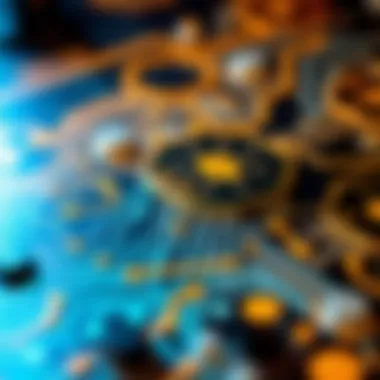

- Decentralization: Unlike traditional databases, where a single entity manages the information, blockchains distribute control among many nodes. This reduces the risk of censorship or manipulation.
- Immutability: Once data is entered into a blockchain, altering it is virtually impossible. This characteristic ensures that once an NFT is created and sold, its ownership history and details remain intact and traceable.
- Transparency: Blockchain systems provide a public ledger accessible to anyone. This feature fosters trust as all transactions related to an NFT can be verified rather than hidden behind the curtain of private databases.
The Ethereum blockchain, in particular, has become the go-to platform for creating NFTs thanks to its robust functionality and wide adoption. It supports specific standards like ERC-721 and ERC-1155, which define unique properties for NFTs, facilitating their creation and management.
"Blockchain doesn't just change the game; it rewrites the rules entirely."
Creators and collectors can navigate artworks' provenance in ways previously impossible, allowing artists to set conditions on their work's resale and ensuring they receive royalties for future sales. The potential reshaping of artist revenue streams is indeed a significant advantage that NFTs present.
Smart Contracts Explained
Smart contracts are an essential element of the NFT ecosystem. These are self-executing contracts with the terms of the agreement written directly into lines of code. When a specific condition is met, the smart contract performs the action automatically. Here’s how they operate in the NFT landscape:
- Automated Transactions: Smart contracts reduce the need for intermediaries by executing terms automatically once conditions are verified. This results in faster transactions and reduced costs for artists and buyers alike.
- Royalty Enforcement: Artists can define royalty percentages in smart contracts. This means that every time their artwork is resold, the smart contract automatically pays the predetermined percentage back to the artist. This continuous revenue stream is a welcomed shift:
- Programmability: Smart contracts can include a variety of parameters such as changing ownership, enforcing scarcity, and establishing utility based on interactions within ecosystems like virtual worlds or online exhibitions.
- For example, if an artist sells an NFT for $1,000 with a 10% royalty, they earn $100 each time it is resold, fostering a connection between the creator and their work.
Given these unique features, smart contracts strengthen the NFT framework, ensuring artists' rights are preserved and clearly defined for potential buyers. By embedding their intentions directly into the code, creators have more control over how their work is treated in the digital space.
The significance of this technology cannot be understated. While digital art has always faced challenges regarding ownership and monetization, the blend of blockchain and smart contracts addresses these issues head-on, leading to new possibilities for the art world.
For further reading on blockchain and smart contracts, you might consider resources like Wikipedia's Blockchain Overview or MIT's Exploration of Smart Contracts.
The Market for NFT Art
The world of NFT art is not just a passing trend—it's a dynamic and rapidly developing market that blends traditional art concepts with cutting-edge technology. Understanding the marketplace for NFT art is central to grasping how digital assets are reshaping the art landscape. This section will dissect various elements crucial to the market, exploring its current landscape, the experiences of artists and buyers, and the economic implications of this novel digital frontier.
Overview of NFT Marketplaces
NFT marketplaces serve as the primary platforms where digital art transactions take place. Think of these spaces as vibrant bazaars, bustling with artists showcasing their work and collectors hunting for unique pieces. Various platforms cater to different audiences and types of art.
Some well-known NFT marketplaces include OpenSea, Rarible, and Foundation, each having its unique features and community focus.
- OpenSea: Often hailed as the eBay for NFTs, OpenSea allows users to trade a wide variety of digital assets—from artworks to domain names. It's an expansive market, hosting numerous creators across multiple genres.
- Rarible: This platform comes with a twist: it allows users to become co-owners through a governance token. Artists and sponsors can influence the platform’s direction, creating a sense of community.
- Foundation: Focusing on artists, Foundation operates on an invite-only basis to maintain quality. It connects creators with collectors who appreciate art at a deeper level.
Participating in these marketplaces requires users to navigate different protocols and transaction fees. Notably, fees can vary significantly across platforms, affecting an artist's net revenue. Understanding these nuances will empower both creators and buyers in their endeavors.
Price Dynamics and Valuation
When it comes to pricing NFT art, it's a bit of a wild ride. Unlike traditional art, where pricing often hinges on the artist's reputation and gallery exhibitions, NFT art valuation varies widely, influenced by other factors including scarcity, uniqueness, and community engagement.
A few aspects affect price dynamics profoundly:
- Scarcity: Limited editions or one-of-a-kind pieces can command a higher price. The more exclusive an NFT is, the more likely it is to attract serious collectors willing to pay a premium.
- Artist Recognition: Just like in the physical art world, the name behind the piece can drastically alter its value. If an artist gains recognition, the value of their previous works can skyrocket.
- Market Demand: Trends can shift quickly—what's hot today may lose its luster tomorrow. Keeping an eye on market sentiment is vital.
- Utility: Some NFTs grant holders additional benefits, such as access to events or exclusive content. Such added value can elevate the price.
In a notable instance, digital artist Beeple sold an NFT for $69 million at a Christie’s auction, shaking the foundations of both the art and tech worlds. This sale not only showcased the potential of individual NFTs but also set a new gold standard, influencing how other pieces are perceived and priced.
“The value of an NFT is not just in the digital asset itself but also in the narrative around it, the community that supports it, and the utility it may provide.”
Navigating the marketing landscape for NFT art reveals both opportunities and complexities that require keen insights. For artists, understanding these variables can greatly influence their success, while investors and collectors should remain observant to capture the ever-changing dynamics at play.
Impacts on Artists and Creators
Non-fungible tokens (NFTs) are shaking up the art world like a sudden gust whipping through a gallery. Artists and creators alike find themselves at a pivotal intersection where technology meets creativity, brought forth by the rise of digital assets. This section dives into the profound impacts of NFTs on artists, illuminating the ways they empower artistic independence while also surfacing some challenges for those steeped in traditional practices.
Empowering Independent Artists
Traditional art markets often cling to established pathways, with gatekeepers like galleries and critics determining whose work sees the light of day. However, NFTs have swung the door wide open, providing a platform where independent artists can showcase their work directly to an audience that resonates with their unique voice. This shift is monumental.
Here’s how NFTs empower these artists:
- Direct Selling: With platforms like OpenSea and Rarible, artists can sell their creations without intermediaries. This direct-to-consumer approach often allows them to retain a greater share of the profits.
- Global Reach: The digital nature of NFTs means an artist in a small town can reach collectors and fans worldwide. It can feel like showcasing one's work in a bustling international art fair—all from the comfort of one's studio.
- Royalties: Smart contracts embedded in NFTs often include provisions for artists to earn royalties on secondary sales. This means that as their work appreciates in value, they can continually benefit from its success.
It's not all sunshine and rainbows, though. Artists also face hurdles:
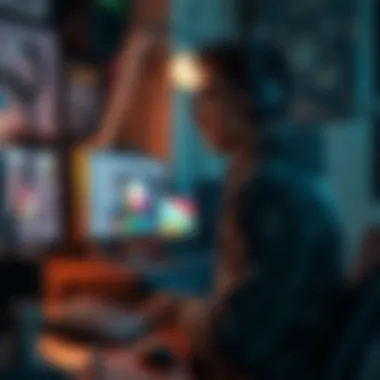

- Tech Barriers: While the shift is thrilling, not every artist is tech-savvy. The software and processes surrounding blockchain can feel daunting, creating a barrier to entry.
- Market Saturation: The ease of minting an NFT can lead to a flooded market, making it challenging for artists to stand out and be discovered.
Challenges for Traditional Artists
For artists entrenched in the traditional forms of art, the NFT wave might feel more like a tide threatening to wash them away. Many have built careers depending on physical mediums and established art circuits—now, they must navigate this brave new world of digital art.
Here are key challenges faced by traditional artists:
- Authenticity and Value: The concept of ownership shifts fundamentally with digital creations. For seasoned artists who pride themselves on originality and tactile experiences, the idea of a digital equivalent can seem less valuable. Certain collectors may hesitate to invest in pieces they perceive as lacking the physicality and history of traditional art, leaving some artists questioning their place in this landscape.
- Changing Relationships with Galleries: Established galleries may struggle to adapt to this new reality. Many traditional artists rely on galleries for promotion, exhibition, and sales. The dynamic is shifting, and some artists may find themselves torn between existing relationships and new opportunities that NFTs present.
Moreover, the intense focus on NFTs has the potential to sideline the broader art discourse. While digital art gains attention, where does that leave those passionate about painting, sculpting, or printmaking? The challenge becomes how to integrate these traditional forms with the innovations NFTs bring, rather than seeing them as oppositional forces.
In summary, the impacts of NFTs on artists and creators are complex. They can empower independent voices while also presenting challenges for those grounded in the traditional art world. This evolving dialogue between the two realms will shape the future of art as we know it, urging both sides to adapt, innovate, and perhaps even collaborate.
"Every innovation brings a new challenge. In the rapidly evolving world of NFT art, the key may be in embracing change while staying true to one's artistic vision."
For further insights into digital art and its impacts, consider exploring sources like Wikipedia's entry on NFTs or articles from credible sources like Britannica that discuss the history and evolution of art in digital realms.
Ownership and Authenticity in the Digital Age
In today’s rapidly evolving digital landscape, the concepts of ownership and authenticity have come to the fore, especially concerning non-fungible token (NFT) art. This section delves into the significance of these two elements, offering insights into their implications not only for artists and collectors but also for the broader art ecosystem.
Rethinking Ownership
Traditionally, ownership of art was relatively straightforward; possessing a physical piece meant having a clear claim over it. However, NFT art shakes that model up. With NFTs, the digital certificate of ownership exists independently of the artwork itself, which can often reside across various platforms or even be copied innumerable times. This prompts a reevaluation of what it means to own art in a digital age.
Key Considerations:
- Digital Provenance: NFTs record the entire transaction history, enabling buyers to trace the ownership back to the original creator. This transparency is a boon for both artists and collectors, assuring all parties involved regarding the legitimacy of ownership.
- Scarcity vs. Replication: Even though files can be duplicated effortlessly, the NFT confers a unique status to the original item. Holding an NFT can symbolize ownership of an original in a world where all things digital are inherently reproducible.
- Personal Connection: People often invest in art beyond financial considerations; they seek a connection with the creator. This emotional bond can be maintained even when ownership is represented through digital means.
- Changing Expectations: Buyers now engage with digital art differently. They no longer simply acquire a piece; they become part of a community that values the creator's vision, often leading to discussions about the art itself, trends, and the culture surrounding it.
As we navigate through this new paradigm of ownership, it’s essential for investors and collectors to fully grasp the mechanics behind NFT transactions and what they truly represent.
Ensuring Authenticity
As the adage goes, "seeing is believing," but in the digital realm, seeing doesn’t always equate to authenticity. That’s where NFTs aim to bridge the gap. Authenticity, in this context, speaks to verifying the originality of the work and its creator's legitimacy. Here are several factors contributing to ensuring authenticity:
Authenticity Mechanisms:
- Blockchain Technology: The backbone of NFTs is blockchain, which provides a secure and transparent ledger for recording transactions. This technology makes it nearly impossible to forge ownership.
- Smart Contracts: When an NFT is created, a smart contract encapsulates details about the artwork, including ownership rights and any royalties that might be applicable. These contracts automatically execute transactions when conditions are met, enhancing trust.
- Digital Signatures: Artists can utilize cryptographic signatures to maintain provenance over their works, establishing a clear link between their creation and the digital token that represents it.
- Platform Verification: Many NFT marketplaces implement stringent verification processes to ensure that artworks listed as NFTs are legitimate. Through authentication checks, they mitigate the risk of counterfeits entering the market.
With the technology continuously evolving, the art world can leverage these advancements to foster an environment of trust and credibility, which fundamentally reinvents the landscape of ownership and authenticity.
Important Insight: While NFTs provide innovative methods to assert ownership and authenticity, the potential for misuse and deception in the digital realm still needs attention.
In summary, as we embrace this digital revolution in the art world, understanding ownership and authenticity becomes vital not just for financial investments but for nurturing relationships between creators and collectors across a vast, interconnected domain of creative expression.
Future Trends in NFT Art
The landscape of NFT art is evolving at a breathtaking pace, and understanding the emerging trends within this space is crucial for stakeholders. This section explores key aspects that will potentially shape the future of NFT art, emphasizing the integration with new digital realms and the influence of advancing technologies.
Integration with Metaverse
The concept of the metaverse, a collective virtual space where users can interact in a computer-generated environment, is gaining traction. NFT art is uniquely positioned to become a backbone of this digital universe. As virtual reality (VR) and augmented reality (AR) technologies mature, artists and collectors will have new ways to engage with art.
Imagine galleries that exist entirely in virtual worlds, allowing artists to showcase their work without the constraints of physical space. Users can roam through these spaces, experiencing art in immersive ways. This could also foster international reach for artists who may be limited by geographic barriers. High-profile examples are already emerging, showing how creators utilize platforms like Decentraland or Cryptovoxels.
Additionally, the blurred lines between gaming and digital art present opportunities for NFT creators. Gamified experiences can integrate NFT art, transforming a static piece into an interactive asset within a game. This innovation enhances user engagement and offers new monetization avenues for artists, potentially brightening their earnings.
"The metaverse isn't just about creating new worlds; it's about reimagining the way we interact with art and each other."
Emerging Technologies and Innovations
As we look further ahead, the adoption of emerging technologies is shaping how NFT art is created, bought, and sold. The convergence of artificial intelligence (AI) with NFTs is one aspect to keep an eye on. Artists are leveraging AI to develop unique pieces that prompt viewers to think beyond traditional artistry. For instance, algorithms can create art that evolves based on user interaction or environmental inputs.


In addition, developments in blockchain technology are making transactions smoother and more secure. Layer-2 solutions aim at reducing energy consumption and transaction fees, which can open the door for wider participation in creating and trading NFTs. As scalability issues get addressed, we'll likely see broader markets for various forms of digital art flourish.
Moreover, the rise of cross-chain technology means that NFTs could potentially operate across different blockchain systems. This innovation could enhance interoperability and liquidity, allowing collectors to buy, sell, or trade NFT art much more seamlessly than before.
- Impact on User Experience: Enhancing user interfaces for marketplaces can lower the barrier for entry.
- Sustainability Focus: New methods of minting NFTs aim to minimize the environmental footprint of art creation.
- Community-Driven Initiatives: Collaborative platforms are sprouting, inviting users to co-create and curate art, redefining ownership.
As NFT art continues to mature, keeping abreast of these trends not only benefits investors and analysts but also educates enthusiasts and creatives on the vast potential awaiting in this rapidly changing field.
Environmental Concerns and Sustainability
In the surge of interest surrounding non-fungible tokens (NFTs) and their artistic implications, a critical dialogue emerges around their environmental footprint. For those diving into the landscape of NFT art, understanding this aspect is as important as grasping the technology or market dynamics. The energy demands of blockchain operations, primarily due to Ethereum's PoW mechanism—though it's shifting toward proof-of-stake—spark a necessary conversation about sustainability in the art world.
The significance of addressing environmental concerns is multi-fold:
- It emphasizes the responsibility artists and collectors hold towards the planet.
- It highlights emerging sustainable alternatives and practices that can minimize negative impacts.
- It serves to educate stakeholders on making informed decisions in the art marketplace, where profits can sometimes overshadow ecological considerations.
Energy Consumption of Blockchain
When we look at the energy consumption of blockchain networks, particularly those supporting NFTs, the numbers can be staggering. The process of minting NFTs and conducting transactions often involves complex algorithms requiring intensive computational power. For instance, prior to Ethereum's transition plans, its Proof of Work algorithm was infamous for high energy usage equating to the consumption levels of small countries.
Key Factors:
- Mining: Each transaction validated requires a significant amount of energy. The Ethereum blockchain, at its peak, was reported to use about 78 TWh annually—comparable to countries like the Netherlands.
- Carbon Emissions: The reliance on fossil fuels for energy production further exacerbates environmental concerns, leading to increased carbon footprints.
"The rise of NFTs should not come at the cost of the Earth. Awareness and action are vital to reshaping this digital art landscape."
Addressing these issues can lead to actionable steps towards reducing energy consumption and promoting greener practices in the digital art sphere.
Sustainable Practices in NFT Creation
Amid these pressing concerns, a silver lining starts to emerge: the adoption of sustainable practices in NFT creation is gaining traction.
- Shift to Proof of Stake: Major platforms are transitioning to less energy-intensive models. Ethereum's move toward proof of stake aims to drastically reduce energy consumption by over 99%, making it a frontrunner in eco-friendly blockchain operations.
- Eco-Friendly Blockchains: Some new blockchain platforms like Tezos and Flow are inherently designed to be more environmentally mindful. They use significantly lower energy to validate transactions. Artists choosing these options can lead the charge toward responsible NFT art.
- Carbon Offsetting Initiatives: Artists and companies are beginning to get involved in carbon offsetting schemes. They put a portion of their earnings into environmental projects, helping restore nature or support clean energy.
Legal Considerations in NFT Art
As the world of non-fungible tokens rapidly evolves, several legal considerations come into play, many of which are still finding their footing amid the changing landscape of digital ownership. Understanding the legal mechanics surrounding NFT art is crucial for artists, collectors, and developers alike. This section will delve into the intricacies of copyright issues and the regulatory environment, showcasing how these elements affect the creation, sale, and distribution of NFT art.
Copyright Issues
One significant area of legal concern in NFTs is the intricacies of copyright. Artists often naively assume that minting their work as an NFT grants them blanket rights to that digital asset. However, the legal reality can sometimes be different. For instance, if an artist mints an artwork without fully understanding their ownership rights, they may inadvertently be infringing upon existing copyrights if that work contains copyrighted material or is derived from another creator's labor.
- Ownership vs. Copyright: Owning an NFT does not equate to owning the copyright of the artwork. Buyers should be fully aware that purchasing an NFT usually only grants them ownership of a unique token, not any rights pertaining to reproduction or distribution of the associated artwork.
- Licensing Agreements: Many artists might opt to include specific licensing terms when they sell their NFT. These terms can delineate how the digital work can be used. It’s vital for both parties involved, the creator and purchaser, to clarify these points beforehand to avoid misunderstandings down the line.
In a nutshell, copyright issues are complex, and both artists and buyers should consult legal professionals to ensure they understand their rights and responsibilities.
“It’s essential for both artists and collectors to comprehend that the legal framework governing NFTs is still developing, thus proactive legal advice can save a lot of headaches.”
Regulatory Environment
Just like the wild, wild west, the NFT space often appears to be a lawless frontier. Yet, this is beginning to change as regulators worldwide take notice of the booming industry. The regulatory environment governing NFTs remains uncertain, with different countries taking varied approaches.
- Region-Specific Regulations: Countries like the United States have been slow to formulate concrete regulations for NFTs, leading to confusion among creators and investors. In contrast, nations in Europe like France are actively advancing their regulatory frameworks, integrating NFTs into existing financial regulations.
- Tax Implications: Understanding how different jurisdictions assess taxes on NFT transactions is essential. For instance, in some areas, NFTs are considered taxable assets, impacting how sales and trades are reported.
As regulations evolve, staying informed on compliance matters becomes paramount. For creatives and collectors alike, it’s crucial to keep a pulse on legal developments surrounding NFTs to safeguard interests and ensure adherence to the law.
In summation, navigating the legal aspects of NFT art can feel like walking a tightrope. However, grasping the nuances of copyright and keeping an eye on regulatory changes can provide a clearer path in this dynamic digital landscape.
Closure
In wrapping up our exploration of non-fungible token art, it's essential to grasp the profound implications this technology has on the art world. The shift from physical to digital assets has ushered in a new era, transforming how we perceive ownership, display, and appreciate art. With NFTs, artists gain a unique avenue that empowers them to engage directly with their audience, and potentially reap greater rewards for their creations compared to traditional art sales.
A few key aspects stand out regarding the importance of NFT art:
- Redefining Ownership: The notion of ownership is shifting. Owning an NFT is akin to possessing a unique digital item. The blockchain records this ownership, creating a transparent history and establishing authenticity, which is crucial in deterring art forgery.
- Creator Benefits: Artists can embed royalties within smart contracts, allowing them to earn from future sales of their work. This model offers them continuous revenue and a stake in their creations well beyond the initial sale.
- Market Expansion: The accessibility of NFT platforms means a broader audience can engage with art. Fairly priced digital art makes it possible for new collectors to enter the market, leading to exciting cultural exchanges.
"Art is not freedom from discipline, but disciplined freedom." – John F. Kennedy
This quote resonates well in the NFT sphere, where artists maintain creative control while adapting to a structured, digital medium.
Despite the promising possibilities, it's crucial to acknowledge the challenges as well. Environmental concerns related to blockchain energy consumption and the legal grey areas around copyright remain pressing issues. As both technology and society evolve, artists, investors, and consumers will need to collaboratively navigate these complexities.
